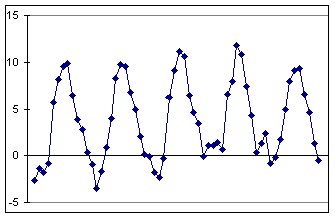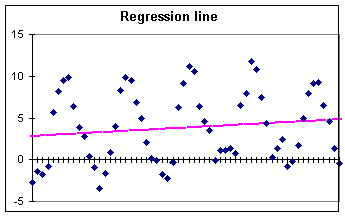
|
Figure 1. A 2nd order DE solution. The general solution of a linear and homogenous differential equation with constant coefficients, y'' + py + qy = 0, can be programmed in Excel, given some values for the DE constants p and q, as well as the constants k1 and k2 which define the initial conditions. The sign of the characteristic equation p·p - 4·q, shown below the control panel, decides if the DE has real or complex roots. A negative value gives rise to two complex roots and a solution of damped oscillations. |

|
Figure 2. A DE numerical solution. A family of solutions for a general 2nd order differential equation is shown on the picture. |
 |
Figure 3.a. Time series analysis. The data on the graph show the average monthly temperatures at a weather station in Iceland over a five year period. The all the following data analysis is carried out by mathematical functions frovided in Excel and its add-in Analysis Toolpack. |
 |
Figure 3.b. Trend analysis. A variety of trend lines can be automatically fitted to the data and the resulting mathematical function can also be displayed on the chart. A linear trend has been fitted to the data in the figure and the line parameters (not shown) used to calculate the trend values. |
 |
Figure 3.c. Residual values. The trend values from 3.b have now been subtracted from the original data, leaving residual values fit for periodic analysis. A weak second order trend with a peak in the middle of the graph is visible here and its reality might be discussed with the students. |
 |
Figure 3.d. A power spectum. Excel supports the calculation of a discrete Fourier transform of the data. This material, however, is only suitable for the more mathematically advanced students and is not discussed in the textbook, but is included on the webpages. |
 |
Figure 3.e. Autocorrelation. An easier way to detect periodicity in a signal is to do calculate the autocorrelation for the series. Since the temperature data is dominated by annual oscillations, the autocorrelation graph is very regular. Less regular data, for example the classic sunspot data also included on the webpages, shows a much more irregular autocorrelation. |